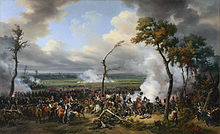
Back Schlacht bei Hanau German Batalla de Hanau Spanish Bataille de Hanau French Hanaui csata Hungarian Battaglia di Hanau Italian 하나우 전투 Korean Pugna apud Hanau Latin Bitwa pod Hanau Polish Bătălia de la Hanau Romanian Сражение при Ганау Russian
| Battle of Hanau | |||||||
|---|---|---|---|---|---|---|---|
| Part of the German campaign of the Sixth Coalition | |||||||
 Battle of Hanau, Horace Vernet | |||||||
| |||||||
| Belligerents | |||||||
|
|
| ||||||
| Commanders and leaders | |||||||
|
|
| ||||||
| Strength | |||||||
| 17,000–30,000 | 43,000 | ||||||
| Casualties and losses | |||||||
| 4,500[1]–5,000[2] killed and wounded |
6,000[2] killed and wounded 4,000 captured[2] | ||||||
Location within Europe | |||||||
current battle
Napoleon in command
Napoleon not in command
The Battle of Hanau was fought from 30 to 31 October 1813 between Karl Philipp von Wrede's Austro-Bavarian corps and Napoleon's retreating French during the War of the Sixth Coalition.
Following Napoleon's defeat at the Battle of Leipzig earlier in October, Napoleon began to retreat from Germany into France and relative safety. Wrede attempted to block Napoleon’s line of retreat at Hanau on 30 October. Napoleon arrived at Hanau with reinforcements and defeated Wrede’s forces. On 31 October Hanau was in French control, opening Napoleon’s line of retreat.
The Battle of Hanau was an important tactical victory allowing Napoleon’s depleted army to retreat onto French soil to prepare to face an invasion of France.
- ^ Eggenberger 1985, p. 187.
- ^ a b c Tucker 2010, p. 1107.

